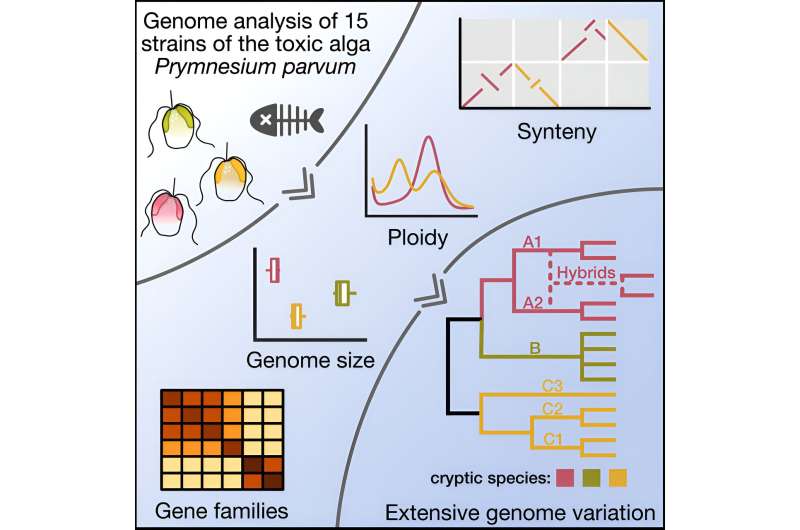This article has been reviewed according to Science X's editorial process and policies. Editors have highlighted the following attributes while ensuring the content's credibility:
fact-checked
peer-reviewed publication
trusted source
proofread
Exposing the hidden genetic diversity of an ecologically harmful microbe

A microscopic species of algae is causing toxic algal blooms around the world, affecting two dozen states in the U.S., especially Texas. New research into the genetic diversity of the responsible organism, Prymnesium parvum, could help authorities predict when blooms will occur.
Prymnesium blooms every winter in Texas, leading the Texas Parks and Wildlife Department to monitor several lakes for signs of the next one. "When they bloom, they do more than kill fish. They disrupt whole ecosystems," said Jennifer Wisecaver, associate professor of biochemistry at Purdue University.
Prymnesium, like many other single-celled organisms, along with all animals, plants and fungi, are eukaryotic organisms. Their cells all contain a nucleus. But Prymnesium are also classified as protists, meaning they are neither animal, plant nor fungi. And like plants, Prymnesium has chloroplasts to harness energy from the sun, which makes them algae.
The organism first bloomed in 1980 in the Pecos River. "Since then, Prymnesium has only gotten worse in Texas and its blooms have spread into nearby states," Wisecaver said. Prymnesium has yet to plague Indiana waters, but it has appeared in northern states such as Nebraska, Iowa and West Virginia.
"They can't grow in completely freshwater. They will die," Wisecaver said. "But they are extremely tolerant of low salt levels and can survive in water with only 1% the salinity of typical seawater."
What allows the organism to invade freshwater systems is among the questions Wisecaver's lab is trying to answer. Last year, Prymnesium bloomed for the first time ever in Germany's Oder River, whose waters have a low saline content.
"Prymnesium is a bit of a conundrum," Wisecaver said. "It seems to bloom in suboptimal conditions for the species. It blooms in extremely low salinity and when nutrients aren't very abundant."
Current predictions of when toxic algal blooms will occur are based mainly on water conditions such as nutrients, salinity and temperature. But biological factors also could loom large.
"Different Prymnesium strains can make different types of toxins. Some strains are highly toxic, while others are less so. If we're not accounting for these biological differences, that will affect our ability to predict when blooms will most likely occur and the effect that they'll have on the environment. But before we can study the genes responsible for these differences, we first needed to sequence the genome of these organisms," Wisecaver said.
She and eight co-authors from Purdue, Penn State Harrisburg, University of California San Diego (UCSD) and Florida International University recently published their findings in the journal Current Biology.
At first, Wisecaver thought her group could sequence just one genome for Prymnesium parvum to act as a reference. "Prymnesium genomes are large, being the size of many plant or animal genomes," Wisecaver said.
"Typically, it isn't practical to sequence multiple genomes from a single species. Instead, we planned to compare the genetic composition of strains that differed in toxicity to one reference genome. However, we quickly discovered that there wasn't just one genome to sequence. We needed to sequence many genomes to get a handle on the diversity that was present," she said.
When examined under a microscope, all specimens of Prymnesium look alike. Yet the genomes of the single-celled Prymnesium strains in the new study contained from 115 million to 360 million DNA base pairs.
"That's an incredible variation in genome size. Far too much to be considered a single species," Wisecaver said. "Turns out that blooms of Prymnesium are not just one big population. They are multiple populations, multiple different species."
Figuring out that one of the genomes under analysis was a hybrid proved to be another challenge. "Putting a genome together is like putting together a large, complex jigsaw puzzle," Wisecaver said. "But imagine that we had two jigsaw puzzles mixed together. We thought we were working on one puzzle when we were actually dealing with two. That took extra analysis to figure out."
"Despite the importance of algae, this work is only the second example of a genomic description of algal hybridization," said Timothy Fallon, a National Institutes of Health National Research Service Award Postdoctoral Fellow at UCSD. "It sheds light on a whole mode of evolution that hasn't been well considered because the tools and the road map for how to use them weren't there. Now the tools exist, and through this work a new road map exists to use those tools to study hybridization."
Fallon expects many more algal or protist researchers to discover hybridization cases in the organisms they study. "These hybridizations might be the key behind the evolutionary adaptations they are studying," he said.
The new study shows the drawbacks of classifying single-celled eukaryotic organisms based on their physical form and structure. "That's not sufficient for Prymnesium, and I expect that the same is true for other protists. We may be underestimating a lot of diversity in these groups," Wisecaver said.
More information: Jennifer H. Wisecaver et al, Extreme genome diversity and cryptic speciation in a harmful algal-bloom-forming eukaryote, Current Biology (2023). DOI: 10.1016/j.cub.2023.05.003
Journal information: Current Biology
Provided by Purdue University




















